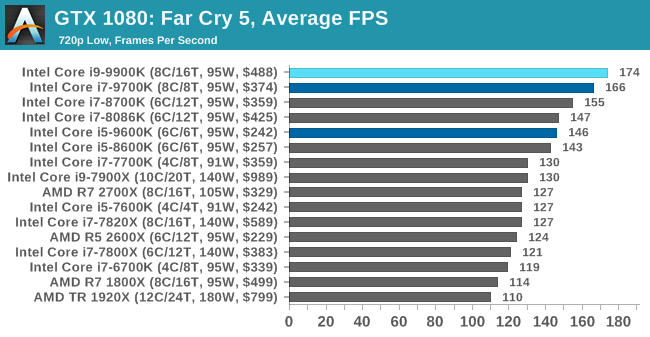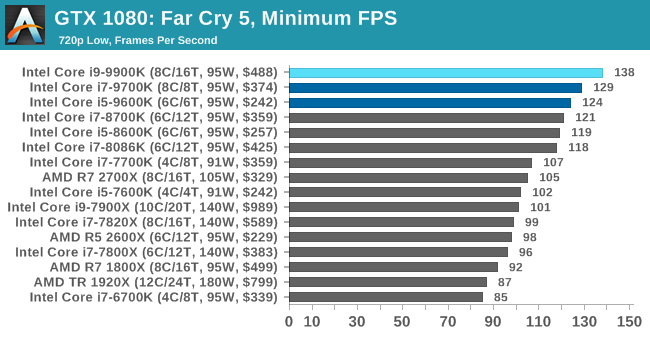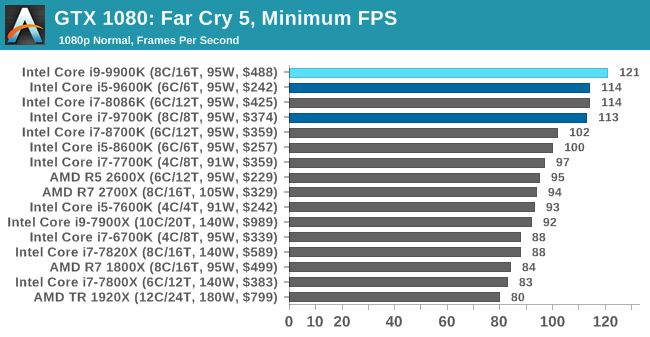The Intel 9th Gen Review: Core i9-9900K, Core i7-9700K and Core i5-9600K Tested
by Ian Cutress on October 19, 2018 9:00 AM EST- Posted in
- CPUs
- Intel
- Coffee Lake
- 14++
- Core 9th Gen
- Core-S
- i9-9900K
- i7-9700K
- i5-9600K
Gaming: Far Cry 5
The latest title in Ubisoft's Far Cry series lands us right into the unwelcoming arms of an armed militant cult in Montana, one of the many middles-of-nowhere in the United States. With a charismatic and enigmatic adversary, gorgeous landscapes of the northwestern American flavor, and lots of violence, it is classic Far Cry fare. Graphically intensive in an open-world environment, the game mixes in action and exploration.
Far Cry 5 does support Vega-centric features with Rapid Packed Math and Shader Intrinsics. Far Cry 5 also supports HDR (HDR10, scRGB, and FreeSync 2). We use the in-game benchmark for our data, and report the average/minimum frame rates.
| AnandTech CPU Gaming 2019 Game List | ||||||||
| Game | Genre | Release Date | API | IGP | Low | Med | High | |
| Far Cry 5 | FPS | Mar 2018 |
DX11 | 720p Low |
1080p Normal |
1440p High |
4K Ultra |
|
All of our benchmark results can also be found in our benchmark engine, Bench.
| Far Cry 5 | IGP | Low | High |
| Average FPS |  |
 |
 |
| Minimum FPS |  |
 |
 |
Far Cry 5 is another game that at reasonable 1080p settings actually shows some CPU differentiation. To really drive a wedge between the CPUs we do need to drop to 720p Low, but still, in both cases the 9900K comes out on top. And in this case the performance gap between it and the 8700K is actually a bit larger than normal at 12%. Still, this is a game that’s if it’s not GPU-bound is closer to being bounded by a limited number of threads, so the lack of major clockspeed gains for the 9900K keep it from pulling too far ahead. It also keeps the 9700K from falling too far behind.












274 Comments
View All Comments
leexgx - Saturday, October 20, 2018 - link
Can you please stop your website playing silent audio, very annoying as it stops playback on my other phone (dual connection headset)moozooh - Sunday, October 21, 2018 - link
To be fair, the 9900K seems like a suboptimal choice for a gaming rig despite the claims—the extra performance is marginal and comes at a very heavy price. Consider that in all the CPU-bound 95th percentile graphs (which are the only important ones in this context)—even in the more CPU-intensive games—the 9700K was within 5% of the 9900K, sometimes noticeably faster (e.g. Civ6 Low). And its overclocking potential is just *so* much better—all of this at ~3/4 the price and power consumption (and hence more relaxed cooling requirements and lower noise). I cannot possibly envision a scenario where a rational choice, all this considered, would point to 9900K for a gaming machine. The at most 5% extra performance just isn't worth the downsides.On a sidenote, I'd actually like to see how an overclocked 9700K fares against overclocked 8700K/8086K (delidded for fair comparison—you seem to have had at least one of those, no?) with regards to frame times/worst performance. For my current home PC I chose a delidded 8350K running at 4.9 GHz on 1–2 cores and at 4.7 GHz on 3–4, which I considered the optimal choice for my typical usage, where the emphasis lies on non-RTS games, general/web/office performance, emulation, demoscene, some Avisynth—basically all of the tasks that heavily favor per-thread performance and don't scale well with HT. In most of the gaming tests the OC 8350K showed frame times about on par with the twice more expensive 8700K at stock settings, so it made perfect sense as a mid-tier gaming CPU. It appears that 9700K would be an optimal and safe drop-in replacement for it as it would double the number of cores while enabling even better per-thread performance without putting too much strain on the cooler. But then again I'd be probably better off waiting for its Ice Lake counterpart with full (?) hardware Spectre mitigation, which should result in a "free" minor performance bump if nothing else. At least assuming it will still use the same socket, which you never can tell with Intel...
R0H1T - Sunday, October 21, 2018 - link
Ryan & Ian, I see that the last few pages have included a note about Z390 used because the Z370 board was over-volting the chip? Yet on the Overclocking page we see the Z370 listed with max CPU package power at 168 Watts? Could you list the (default) auto voltage applied by the Asrock Z370 & if appropriate update the charts on OCing page with the Z390 as well?Total Meltdowner - Sunday, October 21, 2018 - link
Ryan, you do great work. Please don't let all these haters in the comments who constantly berate you over grammar and typos get you down.Icehawk - Saturday, October 27, 2018 - link
Ryan, I still haven't been able to find an answer to this - what are your actual HEVC settings? Because I've got an 8700 @4.5 no offset and it does 1080p at "1080p60 HEVC at 3500 kbps variable bit rate, fast setting, main profile" with passthrough audio and I get ~40fps not the 175 you achieved - how on earth are you getting over 4x the performance??? The only way I can get remotely close would be to use NVENC or QuickSync neither of which are acceptable to me.phinnvr6@gmail.com - Wednesday, October 31, 2018 - link
My thoughts are why would anyone recommend the 9900K over the 9700K? It's absurdly priced, draws an insane amount of power, and performs roughly identical.DanNeely - Friday, October 19, 2018 - link
Have any mobo makers published block diagrams for their Z390 boards? I'm wondering if the 10GB USB3.1 ports are using 2 HSIO lanes as speculated in the mobo preview article, or if Intel has 6 lanes that can run at 10gbps instead of the normal 8 so that they only need one lane each.repoman27 - Friday, October 19, 2018 - link
They absolutely do not use 2 HSIO lanes. That was a total brain fart in the other article. The datasheet for the other 300 series chipsets is available on ARK, and the HSIO configuration of the Z390 can easily be extrapolated from that.HSIO lanes are just external connections to differential signaling pairs that are connected internally to either various controllers or a PCIe switch via muxes. They’re analog interfaces connected to PHYs. They operate at whatever signaling rate and encoding scheme the selected PHY operates at. There is no logic to perform any type of channel bonding between the PCH and any connected ports or devices.
TEAMSWITCHER - Friday, October 19, 2018 - link
My big question ... Could there be an 8 core Mobile part on the way?Ryan Smith - Friday, October 19, 2018 - link
We don't have it plotted since we haven't taken enough samples for a good graph, but CFL-R is showing a pretty steep power/frequency curve towards the tail-end. That means power consumption drops by a lot just by backing off of the frequency a little.So while it's still more power-hungry than the 6-cores at the same frequencies, it's not out of the realm of possibility. Though base clocks (which are TDP guaranteed) will almost certainly have to drop to compensate.